A three-dimensional map of the Milky Way using classical Cepheids
Based on direct distances to thousands of individual classical Cepheids, a unique three-dimensional map of the Milky Way has been constructed. The map provides insights into the structure and history of our Galaxy. It demonstrates that the Milky Way disk is not flat, it is warped at distances greater than 25,000 light years from the Galactic center. Moreover, the Galactic disk does not have a constant thickness - it flares with the increasing distance from the Galactic center. The Galactic disk is about 500 light years thick near the Sun, whereas over 3,000 light years near its edge. Additionally, the age tomography of the Milky Way has been performed. It turned out that the youngest Cepheids are located near the Galactic center, while the eldest - in the outer regions of the Milky Way's disk.
See the papers by Skowron et al. (2019a) and Skowron et al. (2019b).
More details on this website.
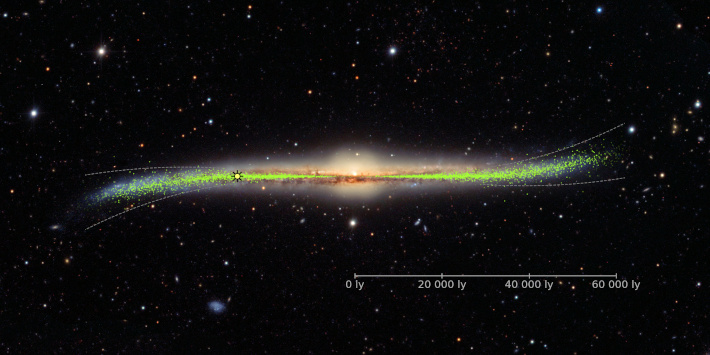 Spatial distribution of classical Cepheids shows that the Galactic disk is warped (Jan Skowron).
Spatial distribution of classical Cepheids shows that the Galactic disk is warped (Jan Skowron).

The OGLE Collection of Cepheids in the Milky Way
The OGLE collection contains 1974 classical Cepheids, 1626 type II Cepheids, and 122 anomalous Cepheids located in the area of about 3000 square degrees covering the disk and bulge of the Milky Way.
See the papers by Soszyński et al. (2017), Udalski et al. (2018), Soszyński et al. (2020), and Pietrukowicz et al. (2021).
The OGLE Collection of Variable Stars is available from this website.
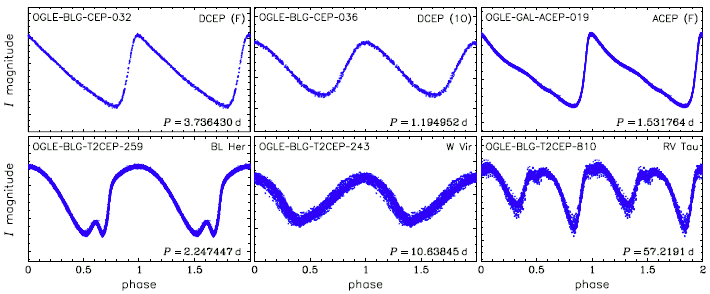 Example light curves of classical, anomalous and type II Cepheids from the OGLE collection.
Example light curves of classical, anomalous and type II Cepheids from the OGLE collection.

Rotation curve of the Milky Way from Classical Cepheids
Flat rotation curves of spiral galaxies are considered as an evidence for dark matter, but the rotation curve of the Milky Way is difficult to measure. We used a sample of 773 classical Cepheids with precise distances based on mid-infrared period-luminosity relations coupled with proper motions and radial velocities from Gaia to construct the most accurate rotation curve of the Milky Way up to the distance of 20 kpc from the Galactic center.
See the paper by Mróz et al. (2019).
The underlying data are available from OGLE Internet Archive.
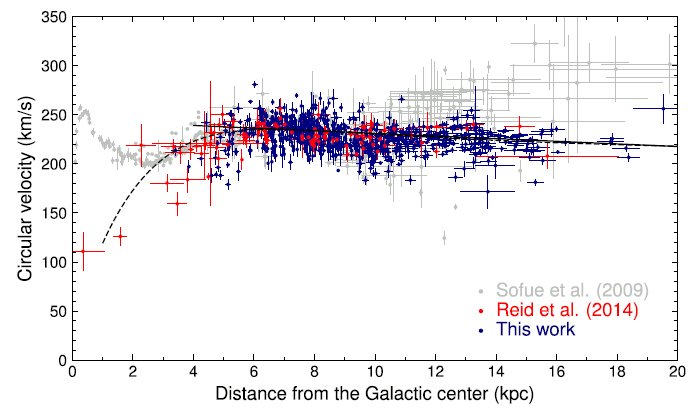 Rotation curve of the Milky Way (P. Mróz).
Rotation curve of the Milky Way (P. Mróz).

Type II Cepheids pulsating in the first overtone
It has long been recognized that various types of Cepheids may oscillate in the fundamental or overtone modes. Type II Cepheids were the exception to this rule, because, until recently, all known objects of that type were pure fundamental-mode pulsators. We discovered the first type II Cepheids in the history of astronomy that pulsate in the first overtone. Two such stars have been identified in the Large Magellanic Cloud and three more in our Galaxy.
See the papers by Soszyński et al. (2019) and Soszyński et al. (2020).
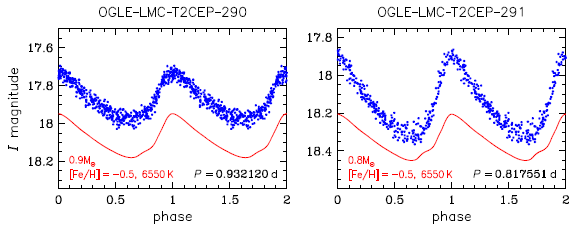
Light curves of the type II Cepheids pulsating in the first-overtone mode.

The first known multi-mode anomalous Cepheid
Anomalous Cepheids are metal-deficient, core-helium-burning pulsating stars with masses in the range 1.2-2.2M☉. Until recently, all known anomalous Cepheids were pure single-mode pulsators. We discovered the first anomalous Cepheid with three modes simultaneously excited.
See the paper by Soszyński et al. (2020).

Disentangled light curve of the anomalous Cepheid pulsating in three radial modes.

The OGLE Collection of RR Lyrae stars in the Milky Way
The OGLE collection contains 78,350 RR Lyrae stars in the Galactic bulge and disk.
See the paper by Soszyński et al. (2019).
The OGLE Collection of Variable Stars is available from this website.
 Example light curves of RR Lyrae stars.
Example light curves of RR Lyrae stars.

The OGLE Collection of δ Scuti-type stars in the Milky Way
The OGLE collection contains 24 488 δ Scuti stars in the Galactic bulge and disk.
See the papers by Pietrukowicz et al. (2020) and Soszyński et al. (2021).
The OGLE Collection of Variable Stars is available from this website.
 On-sky distribution of δ Scuti stars in the Galactic coordinates.
On-sky distribution of δ Scuti stars in the Galactic coordinates.

Binarity as the Origin of Long Secondary Periods in Red Giant Stars
About 30% of bright red giants show additional variability with periods ranging from several months to several years - typically ten times longer than the pulsation period of the same star. The origin of these so-called long secondary periods (LSPs) has remained a mystery for almost a century, since their discovery. The huge OGLE database was used to select an unprecedentedly large sample of around 16,000 LSP stars to investigate their properties. The comparison of the OGLE visual time-series photometry with the WISE infrared light curves showed a surprising difference: additional brightness minima visible only in the infrared range. This behavior can be explained by the presence of an additional object orbiting the red giant star just above its surface. This companion is surrounded by a comet-like dusty cloud, which obscures the giant star once per orbital period and causes the LSP variability. The radial velocity amplitudes of LSP stars suggest that the companions of red giants are usually substellar objects - the so-called brown dwarfs. In this scenario, these low-mass objects were initially planets that increased their masses accreting material from the envelopes of their host stars. This explanation opens up new perspectives for studying extrasolar planetary systems in the Milky Way and other galaxies.
See the paper by Soszyński et al. (2021).
More details on this website.
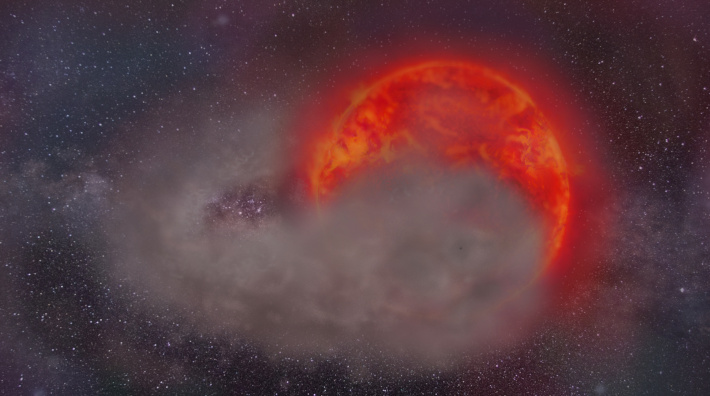 Artistic impression of a red giant star obscured by a dusty cloud surrounding a low-mass companion (Matylda Soszyńska).
Artistic impression of a red giant star obscured by a dusty cloud surrounding a low-mass companion (Matylda Soszyńska).

The OGLE Collection of Mira stars in the Milky Way
The OGLE collection contains 65,981 Mira stars in the Galactic bulge and disk.
See the paper by Iwanek et al. (2022).
The OGLE Collection of Variable Stars is available from this website.
 On-sky distribution of the OGLE Mira stars in the Galactic coordinates (P. Iwanek).
On-sky distribution of the OGLE Mira stars in the Galactic coordinates (P. Iwanek).
| 